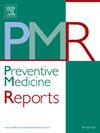中国20-69岁吸烟成年人的社会人口学和吸烟特征与戒烟意向的关系:2018 - 2019年中国健康素养调查结果
IF 2.4
3区 医学
Q2 PUBLIC, ENVIRONMENTAL & OCCUPATIONAL HEALTH
引用次数: 0
摘要
目的以第十版《国际疾病分类》(ICD-10)尼古丁依赖为研究对象,探讨影响我国吸烟者戒烟意向的因素。此外,估计ItQ个体的数量,支持戒烟资源的最佳分配。本研究使用了2018年中国健康素养调查的数据,这是一项具有全国代表性的横断面研究,共有20288名吸烟的参与者,目前年龄在20-69岁之间。对ItQ比例进行总体和亚组估计。采用Logistic回归估计ItQ的or和95% ci。吸烟的人数是根据人口普查数据估计的。结果中国吸烟人群中有41.34%患有ItQ,女性(44.89%)高于男性(41.34%)。省级比例从23.53%到63.56%不等。ItQ与吸烟特征显著相关,包括偶尔吸烟(OR = 2.08, 95% CI = 1.88-2.20)、较少的包年(OR = 0.70, 95% CI = 0.68-0.73)、较大的开始吸烟年龄(OR = 1.22, 95% CI = 1.18-1.27)、ICD-10尼古丁依赖(OR = 1.12, 95% CI = 1.06-1.19),以及年龄、性别、社会经济因素和健康状况。无ICD-10尼古丁依赖者的戒断症状与ItQ呈正相关,而有ICD-10尼古丁依赖者的戒断症状与ItQ呈负相关。据估计,中国有1.003亿20-69岁的成年人患有ItQ,其中5214万人患有ICD-10尼古丁依赖症。结论中国吸烟者的戒烟意愿较低,且因ICD-10尼古丁依赖和地区而异,强调需要针对不同吸烟人群进行有针对性的戒烟干预。本文章由计算机程序翻译,如有差异,请以英文原文为准。
Associations of sociodemographic and smoking characteristics with intention to quit among Chinese adults aged 20–69 years who smoke: Findings from nationwide China Health Literacy Survey during 2018–19
Objective
To identify factors influencing the intention to quit (ItQ) among Chinese who smoke, focusing on 10th Revision of the International Classification of Diseases (ICD-10) Nicotine dependence. Additionally, to estimate the number of individuals with ItQ, supporting optimal allocation of cessation resources.
Methods
This study used data from the 2018 China Health Literacy Survey, a nationally representative cross-sectional study with 20,288 participants who smoke currently aged 20–69 years. The ItQ proportions were estimated overall and by subgroup. Logistic regression was employed to estimate ORs and 95 % CIs for ItQ. The number of people who smoke with ItQ was estimated based on the census data.
Results
In China, 41.34 % of individuals who smoke had ItQ, higher in females (44.89 %) than males (41.34 %). Provincial proportions ranged from 23.53 % to 63.56 %. ItQ was significantly associated with smoking characteristics, including occasional smoking (OR = 2.08, 95 % CI = 1.88–2.20), fewer pack-years (OR = 0.70, 95 % CI = 0.68–0.73), older smoking initiation age (OR = 1.22, 95 % CI = 1.18–1.27), and ICD-10 Nicotine dependence (OR = 1.12, 95 % CI = 1.06–1.19), as well as age, sex, socioeconomic factors, and health status. Withdrawal symptoms were positively associated with ItQ in individuals who smoke without ICD-10 Nicotine dependence but negatively in those with ICD-10 Nicotine dependence. An estimated 100.3 million adults aged 20–69 in China have ItQ, with 52.14 million suffering from ICD-10 Nicotine dependence.
Conclusions
The intention to quit smoking among Chinese who smoke is low and varies by ICD-10 Nicotine dependence and region, underscoring the need for targeted smoking cessation interventions across diverse smoking populations.
求助全文
通过发布文献求助,成功后即可免费获取论文全文。
去求助
来源期刊

Preventive Medicine Reports
Medicine-Public Health, Environmental and Occupational Health
CiteScore
3.90
自引率
0.00%
发文量
353
 求助内容:
求助内容: 应助结果提醒方式:
应助结果提醒方式:


